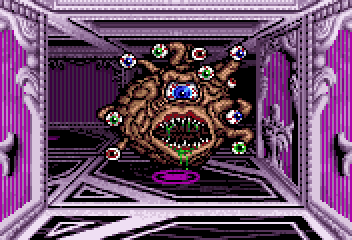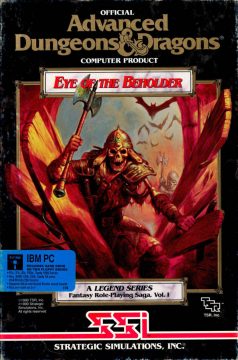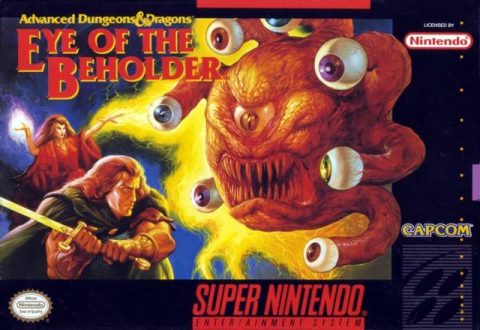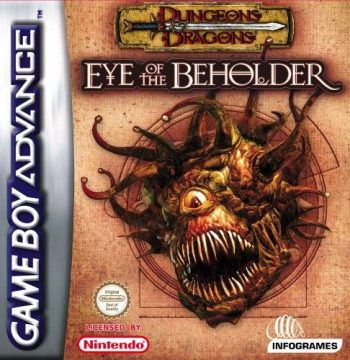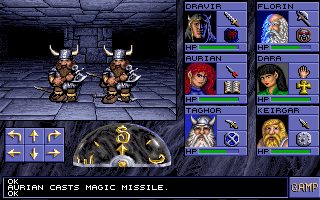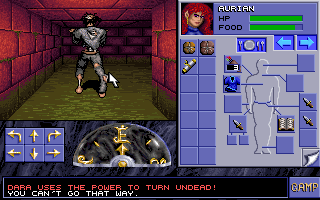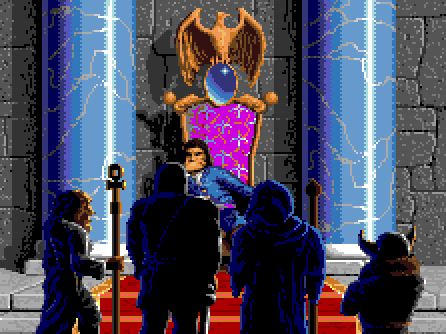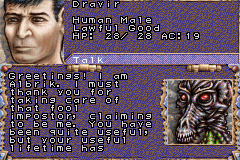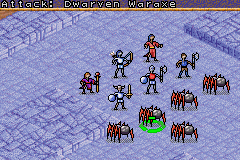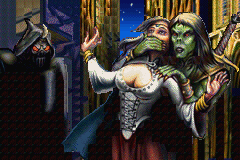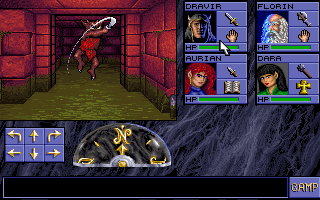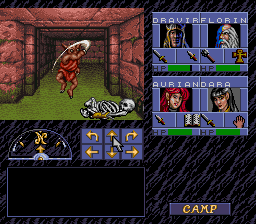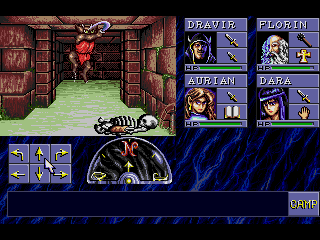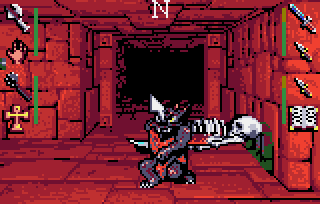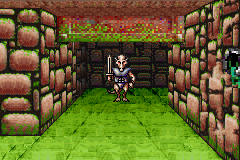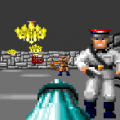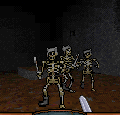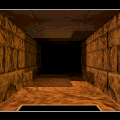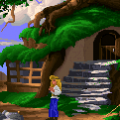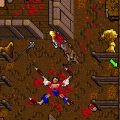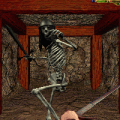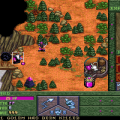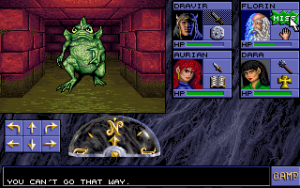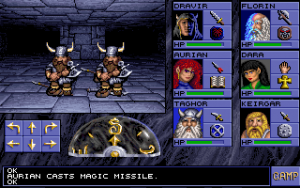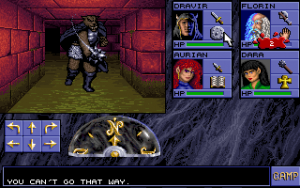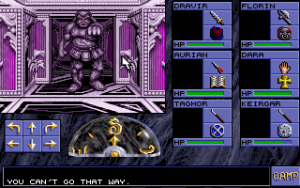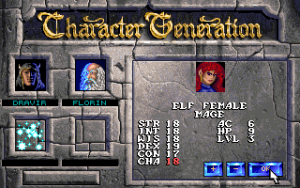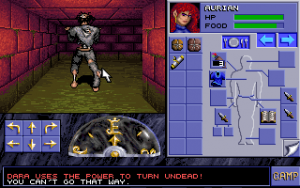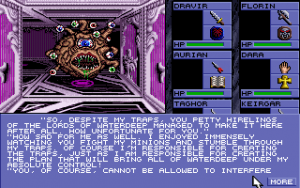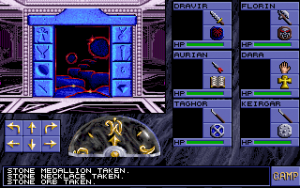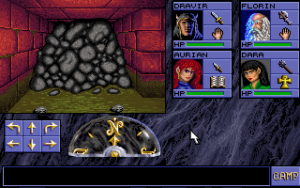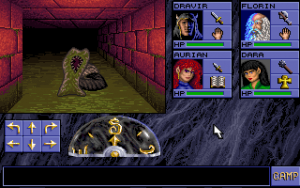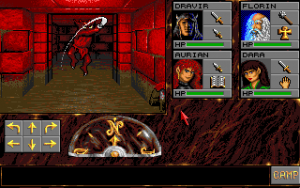In 1987, a company by the name of Strategic Simulations, Inc. (SSI) acquired the license for computer adaptions of Advanced Dungeons & Dragons from TSR, Inc. SSI went on to successfully publish over 30 games using the AD&D license; among those were the Eye of the Beholder games, which were developed along with Westwood Studios.
Taking a hint from the 1987/88 surprise hit Dungeon Master, Eye of the Beholder is a pure dungeon crawling experience that handles exploration and combat seamlessly through a first-person perspective, much unlike other SSI AD&D games from the famous Goldbox series, such as Pool of Radiance or Hillsfar. While first-person dungeon crawlers weren’t anything new at the time, Eye of the Beholder does a great job streamlining the game mechanics found in the genre and offers a more real-time experience rather than turn-based.
Combat benefits the most from this approach, and is handled fairly well. Fights are triggered as you approach enemies without the need to ever enter a battle sequence. As long as you can see the enemy, you can immediately begin combat with long range attacks as you approach; the same goes for your adversaries. The characters in the front row take most of the damage, and can attack with standard melee weapons, while those in the rear can throw weapons or cast spells without being in harm’s way unless, of course, the enemy attacks you from behind. This does add some strategy to how you can approach battles, but ultimately running up to most enemies and simply attacking with your melee characters is all you need to do for most encounters.
Each game usually begins the same way. You can take time to create a party of four adventurers, or choose to import characters from the previous games; a feature that was incorporated into various other SSI games. The story is then introduced through a short cutscene, and your band of explorers are then thrown into some dungeon. Though some characters are reoccurring throughout the series, the narrative seems to have taken a back seat and serves no true purpose rather than to give you reason to hack through monsters.
While Eye of the Beholder doesn’t revolutionize the genre in any way, it still remains one of SSI’s more well-known and successful series. Its streamlined approach to the genre made it more accessible, as did the ports of the first game for the SNES and Sega CD. The general success of the series led to the release of the Eye of the Beholder Trilogy for the PC in 1995, and the games were also included in the collection Gamefest: Forgotten Realms Classics which was released in 2001 by Interplay.
Eye of the Beholder opens with a group of adventurers who have been summoned to the city of Waterdeep. It seems as though some evil is brewing below the city and the group immediately sets off into the sewers. Not far into the underground labyrinth, part of the tunnel collapses and the adventurers are sealed off with no other option than to explore and fight their way through hordes of monsters. As they progress through the dungeon, they learn that a Beholder by the name of Xanathar is behind all of this evil and is planning to take over Waterdeep. You’ll adventure through Dwarven ruins and Drow communities, until ultimately coming upon the lair of Xanathar himself for the final showdown.
Upon starting the game you take some time to create your team of four heroes; choosing their race, class, and approving their stats before beginning the quest. At first you’ll simply start in the sewers of Waterdeep, fighting ordinary kobolds as you go along. The game eventually ramps up the enemy difficulty and floor complexity as you proceed, which makes for a balanced experience. However, the dungeon layout does prove a bit frustrating in later levels, as there is no in-game map and many tiles of the dungeon will teleport or rotate your party without it ever being obvious, just like in the ancient Wizardry games. There are also tons of hidden doors and switches that you must find in order to progress, which just results in more of a headache rather than a deep roleplaying experience.
The magic system is also handled in a more traditional AD&D sense similar to other games from the genre. Instead of being able to cast a spell as long as they have the magic points or mana, instead mages or clerics choose from a list of spells to memorize when they rest. Upon resting the number of uses for spells is restored and decreases as you use them, being refilled yet again only during the next rest.
As mentioned, the combat in Eye of the Beholder is straightforward and fast paced. The game definitely benefits from this as battles never seem to last for too long, and you’re left to focus more on exploring. However, the drawback to this approach is a feeling of little to no depth. While you can view your character’s statistics, and weapons and armor all come with different stat modifiers, it really feels as though it doesn’t make that much of a difference in the end. Battles usually involve nothing more than hacking away at enemies until they’re defeated, with no concern for strategy or tactics.
While Eye of the Beholder doesn’t break new ground with its level design or combat, the game was impressive graphically. The different dungeon locations all have distinctive wall textures, and the enemies have nice animations for their attacks. It has a very clean look to it, and enemy sprites are spot on to their table top counterparts that you would find illustrated in various Dungeons & Dragons Monster Manuals.
The game’s success led to ports for the Amiga, PC-98, SNES, and Sega CD. A port for the Atari Lynx was also planned, but ultimately canceled late in its development cycle. Only recently the all but finished prototype resurfaced and saw an unauthorized indie-release. Though all of these ports stayed true to the original in terms of level design and game mechanics, there were some minor changes. The PC-98 version is currently not runnable in emulators, but if the sequel is any indication the only difference should be the Japanese text. The Amiga version is the next most similar, although the graphics don’t transfer very well to the lower color palette.
The most apparent is the inclusion of music in the SNES and Sega CD versions; the latter received its soundtrack from Yuzo Koshiro (popular for his work on games such as Ys I and II, Beyond Oasis, and the Etrian Odyssey series just to name a few), who delivers some highly genre-atypical drum&bass / industrial tunes. The Sega CD version also received cut scenes and voice acting for the NPCs you encounter, although the voice acting is laughably bad. Both console ports also received an animated ending, which was a great improvement over the few screens of text you got for completing the PC version. However, the console ports did suffer from their gamepad controls. It becomes obvious rather quickly that the game was designed to be played with a mouse, and the transition to console controllers didn’t go over very well.
A remake of the first Eye of the Beholder was released for the the Game Boy Advance in 2002. The game sticks fairly close to the story surrounding Xanathar and his plans to invade Waterdeep. That, however, is where the similarities end. Although the game still plays out in a first person perspective during exploration, battles couldn’t play out any more differently. In the original games, combat was seamless while exploring the various dungeons and temples found throughout the games. Instead, battles now take place in an isometric perspective. You still encounter enemies in the dungeons the same way; you see them from your first person perspective and approach them to cue a fight. But after that you’re now taken to an isometric view of the dungeon itself, heroes and enemies being represented by miniature sprites (a change reflected in the table top game as the use of miniatures has since become more widespread and suggested by the literature). Despite SSI’s absence, the new battle system is reminiscent to many of their older games from the Goldbox series.
The change in combat does help to make things more strategic when planning out your attacks, though it ultimately slows down the flow of the game and ends up being fairly frustrating to control. Just as in the pen-and-paper version of Dungeons & Dragons, you now have to take into account limited character movement per turn as well as opportunity attacks (free attacks granted if someone tries to use ranged attacks next to an opponent, or moves multiple spaces around an opponent within striking distance). Though the idea seems good in theory, when playing through a combat encounter you’ll quickly find that it’s very difficult to maneuver characters around each other in the small corridors of the dungeon. This usually leads to two melee characters stuck up front, while others simply have to wait behind them unless they have some sort of ranged attack.
One aspect from the previous games now expanded upon is the inclusion of more roleplaying elements. Before, interacting with NPCs never got beyond two or three choices for you to pick, which usually resulted in the same events. Now characters have different skills to level up, such as Bluff and Intimidate, which you can use when interacting. Though these don’t play that huge a role, depending on your skill level you can recruit some characters who usually wouldn’t join you, or even avoid battles at times.
The characters and customization in the game have also been enhanced. Some enemies now have dialogue before battles begin, and you’re also able to pick different skills even classes when creating and leveling up your characters. Though this is a very minor addition, it is a nice touch to help develop the game and characters within it. Unfortunately, many of the skills that you’re able to choose from are rarely ever used and never truly add anything to the game.
In the end, however, it still falls far short of the original. The new battle system slows the game down and the controls are very cumbersome. Where it used to be easy to navigate through character inventories, equip weapons and armor, and assign spells; it is now nothing short of frustrating. The game also fails to deliver graphically. Compared to other GameBoy Advance games, the enemy sprites, character portraits, and environments all look rather poor. The sound quality is another fault. Granted the original games weren’t known for having excellent music, or any at all outside of the console ports, they did have a very atmospheric feel to them when it came to audio. Here the sound is nothing more than various canned sound clips that play at seemingly random moments. It comes off as an afterthought, and ends up seeming cheesy rather than atmospheric.
Though this remake does add some interesting and welcomed additions that weren’t present in the original Eye of the Beholder, it fails to live up to the original games.
Screenshot Comparisons
